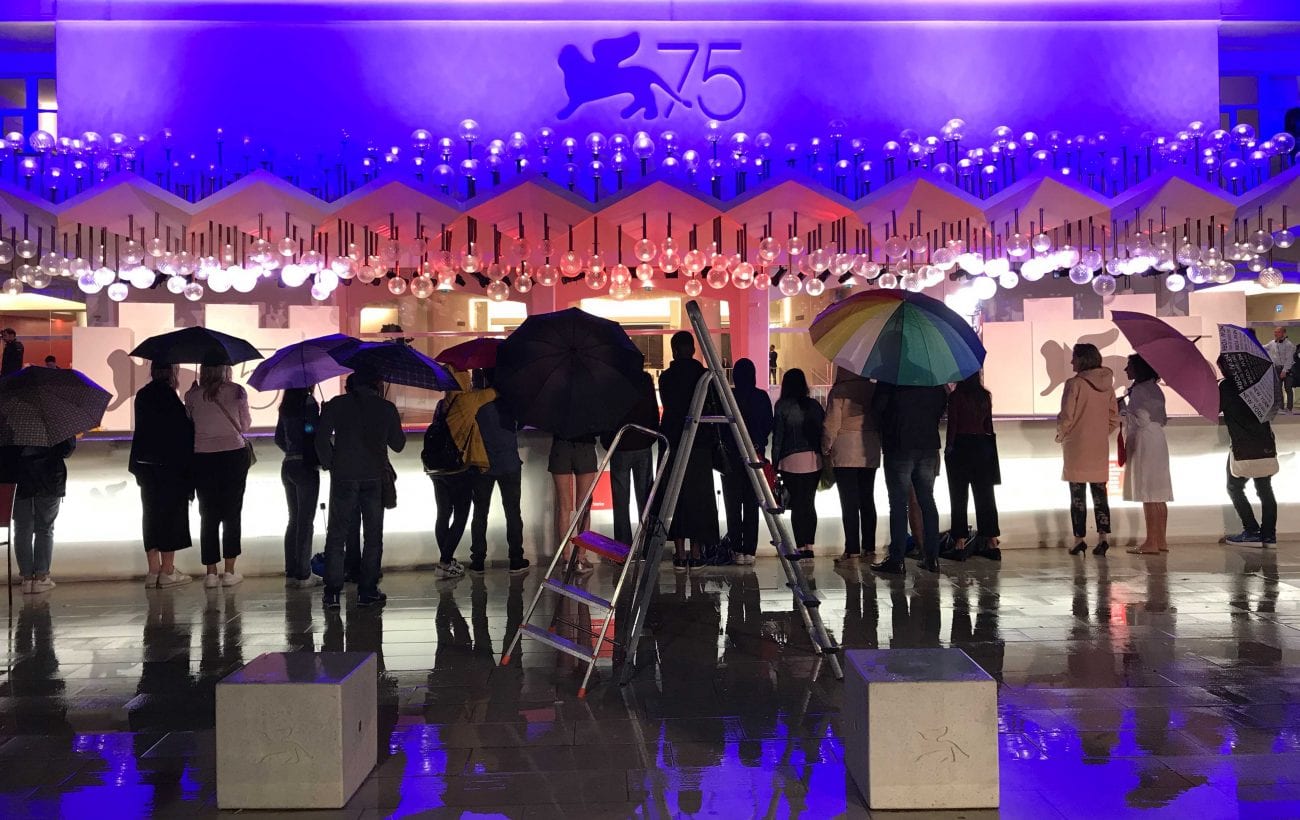It is starting to get colder in Berlin, and I find myself reminiscing about our snug little nook in sunbathed Venice: for the second time, we were given the chance to meet VR and AR professionals from around the world at the Lazzaretto Vecchio. The green courtyard became a setting where creatives, enthusiasts, critics, investors, distributors, and sceptics came together in tranquil harmony to sip their morning cappuccino and chat cheerily about virtual worlds. The talk of the town: how theater and VR came together in Venice. Read in this article more about the two stunning experiences The Horrifically Real Virtuality and Umami.
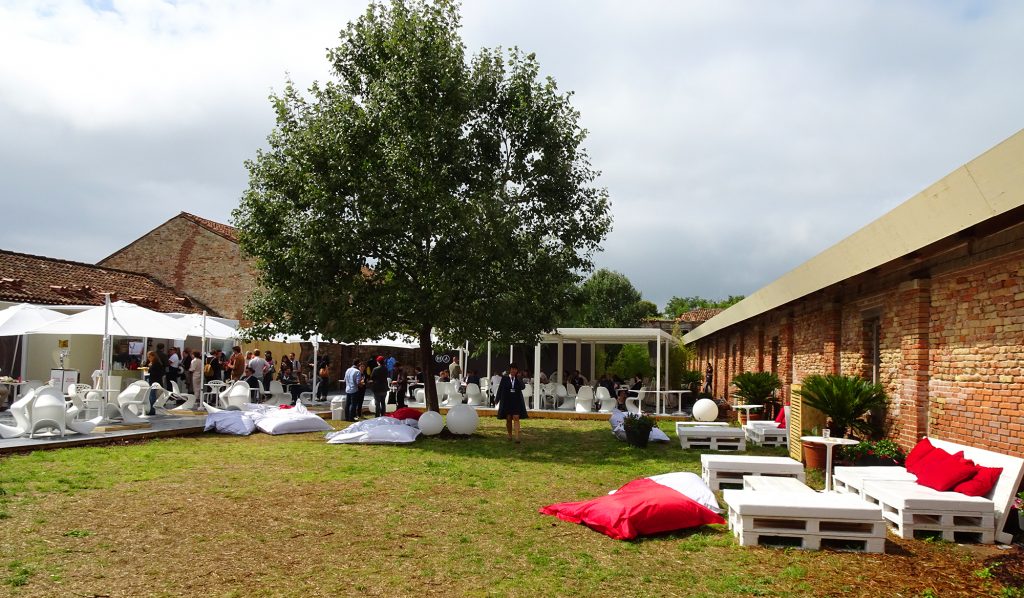
Good Things Need Time
For weeks, I have been trying to summarize all these impressions. Not an easy undertaking, as might be evidenced by the calendar’s last pages… There just were too many gobsmackingly wonderful things to see. You will excuse the delay though, considering that I was at the VR Days in Amsterdam and was being kept quite busy in general – writing an article for various German magazines as well as being a guest at an exciting symposium held at the Fachhochschule Potsdam.
Alas, let us return to Venice for now.
Even though it may have been a while ago: I am still quite proud of myself. Through my “German sense of thoroughness” – I’d like to thank the guys of the podcast VRODOCAST for this apt conclusion – I was able to see all 30 competing VR experiences (and even a few more). Mission accomplished!
This made it all the more difficult to choose my personal highlights. After countless sleepless nights, hours spent sat in front of a static screen, a handful of accidentally ripped-out hairs and many “thinking” days spent in bed (thank gastroenteritis for that one), here are my top projects, part one!
Let us begin with a couple of installations, as these quite literally knocked me off my feet. Not surprising, seeing as these were the most elaborate performances – not only offering a barrage of special effects, but also integrating real actors.
The Horrifically Real Virtuality
The Horrifically Real Virtuality was Venice VR’s largest installation. A production company from Paris, the DVgroup is already familiar with these kinds of projects: director Marie Jourdren was jointly responsible for last year’s piece: Alice – The Virtual Reality Play. Incidentally, she was present in Amsterdam, too. At the VR Days conference, she talked about the play a little bit, saying that – as nothing similar had existed prior – the team felt compelled to invent an entirely new genre for Alice : the immersive theater VR play.
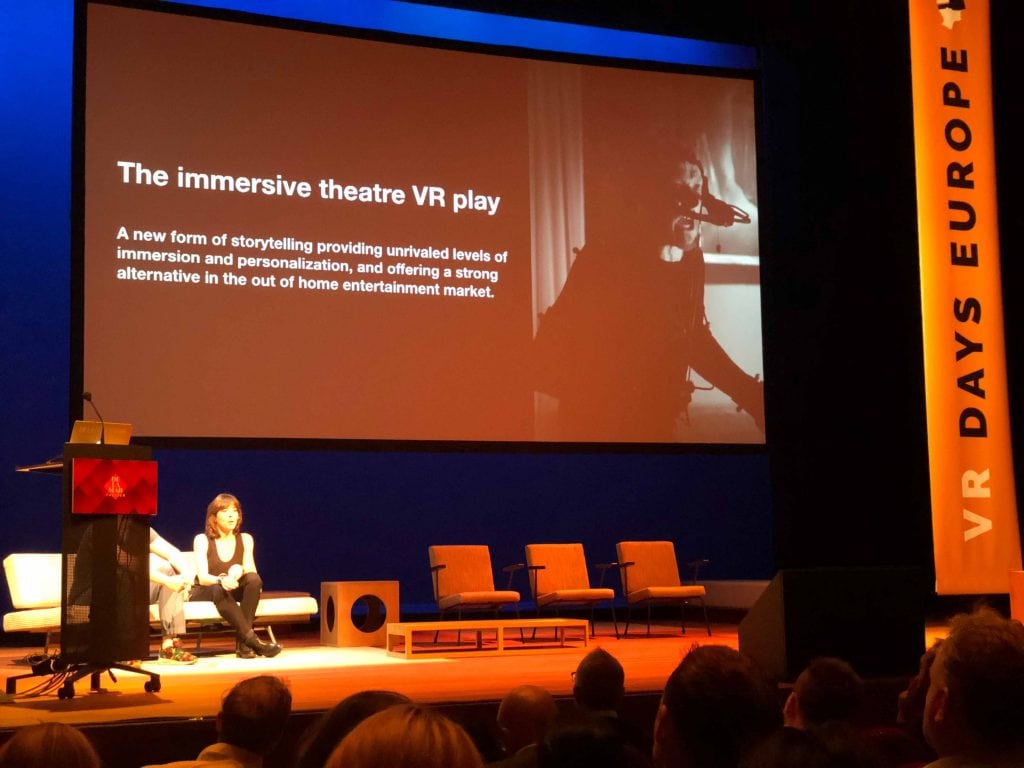
Not really being big into short labels, their new piece’s title feels appropriate: The Horrifically Real Virtuality – which I had the chance to admire in Venice. To this day, I cannot pronounce the entire name without mistakes… I invite those who can to send me an audio recording as proof.
The Show Begins
Because I had been looking forward to this so much, I had arrived at the spot a bit early on the day of the event. While I was waiting there with my fellow players – we were supposed to be six people in all – a young man wearing a disheveled black jacket joined us. We introduced ourselves; to which he simply answered with an odd shrug, adding that his name were Max. It was pretty early and I hadn’t had enough coffee, which is why I only realized what was happening when someone in the group began to giggle: Max was part of the play – the play was in full swing before we even knew it had begun.
Eventually, Max led us into a dim lobby where he began explaining the story to us. The poor guy had his work cut out for him though, constantly being interrupted by people hurrying out from behind the curtains, exclaiming “There’s no time for this!” and “You need to cut it short.” He gave up after a while and we were ushered into the second room. There, we stumbled onto the middle of a film set – an archaic collection of a sofa, an armchair and the odd trinket for decoration.
An actor was standing in front of the sofa, clad in a motion capture suit and making weird grimaces, most likely for the little camera hanging in front of his face. This time around, it didn’t take me too long to figure out what was going on once I had a look at one of the two screens. They showed the same room in black-and-white – however, instead of the actor, an old man was flailing his arms around. Nice, special effects, I thought, more of that, please.
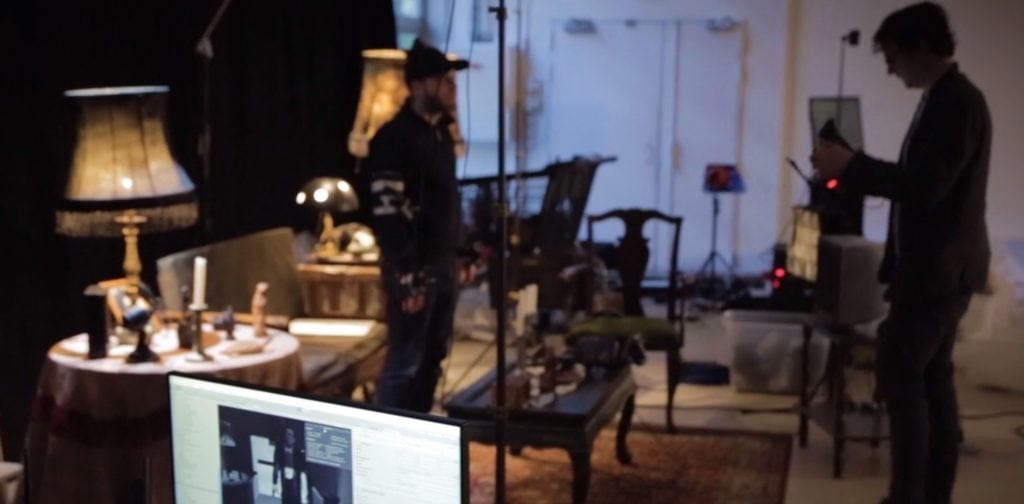
Shut Up and Look Pretty
My wish was granted, as suddenly the director ran into the room. Because he was pressed for time, he explained, we will have to help out. No time to waste! We were promptly assigned our roles. A fellow player was allowed to operate the camera, another would control the sound effects.
And I? I was dropped directly behind the camera and told to just stand there. “Don’t say anything and look the actor in the eye” – my only instructions. The actor poised himself opposite to me and gave it his all as soon as “Action” was called. With a painfully distorted face, he screamed my name while approaching the camera (and me) and going through his monologue.
In my perplexed state I couldn’t remember exactly what he shouted. Supposedly, I was the embodiment of his wife that had been abducted by aliens. Was it my coffee-withdrawal that had barred me from greater responsibility? How I would have loved to operate the camera! Welp, better luck next time. Afterwards, they showed us the freshly shot scene on one of the screens. Even though I was nowhere to be seen (or maybe exactly because of that?), it was masterful!
The Horrifically Real Virtuality: VR in VR in the Theater
Now the time had come for the cinema. We moved to another room that had one of those old ticket booths. Sat there – what a pleasant reencounter! – our man, Max. We were all given a red ticket from the ticket roll. Then we entered the cinema – a clever transition; as to get there, we had to don our VR goggles.
We were now in the virtual world, stood (who would have guessed?) in front of an ostentatious movie theater. Everything was black-and-white as in a silent film. The only thing that seemed out of place was ourselves. At first, I could only see a waist-high disc floating below me. Then I glanced over at my co-players who were visible as avatars in VR – and I laughed. Namely because we all looked rather silly: short, identical men wearing chunky, horn-rimmed glasses and two short antennae on our heads.
Our legs were missing, replaced instead by a sort of flying saucer construction that hovered around carrying our upper bodies. Aside from this just being French humor, there were also technical reasons for doing so. In this way, trackers attached to the feet needed for simulating virtual legs could be eschewed. And so, we floated into the cinema hall on our flying saucers, took our seats and quietly chuckled again about our bizarre appearance. Then, the film started.
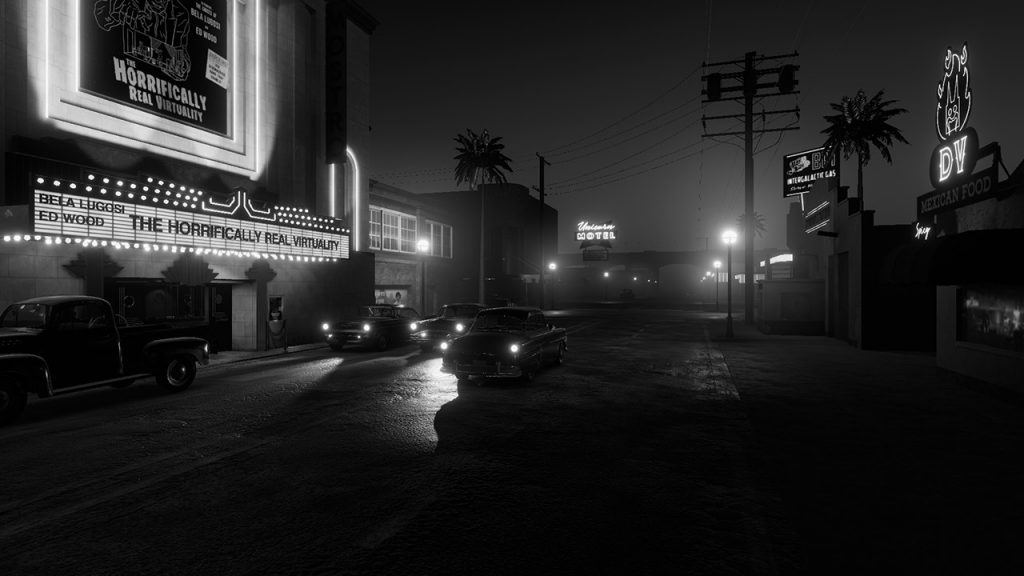
Things quickly got metaphorical. After a couple of minutes in the cinema, our legless bodies began to float into and through the silk screen, and we entered the film. We set foot into another dimension, the so-called Real Virtuality. I’ll let it be at that, because I hope you will be able to experience The Horrifically Real Virtuality for yourselves someday.
One last thing: it was especially nice to see that all of the physical objects in the virtual world were in fact real; just like our friend, the actor Bela Lugosi (not the real one, of course – he has been dead for quite a while – his ghost joined our party). At the end, he had one last big performance, and we had to help him escape from the black-and-white Real Virtuality.
Overall, this was a remarkable experience. A skewed homage to Ed Wood, the “worst director of all times,” and his films. I would have had to have watched his most famous – or rather, infamous – films beforehand to understand all the film quotes… Not to worry, I shall only say: “PULL THE STRING! PULL THE STRING!”
Umami
Umami was a different beast entirely than The Horrifically Real Virtuality. Umami, that’s that hard-to-pin flavor drifting somewhere between tasty, tangy and salty. In any case, we’re talking food here. Well that is just fantastic, I thought, and dove into the installations. I was not quite prepared for what expected me inside…
Let’s jump back a couple of hours first, though. In my thorough German ambition, I had already booked the day’s first appointment and found myself standing in front of the large cube in which the installation had been arranged at 10 in the morning. While I was stood there waiting, I heard a loud clatter. A group of men carrying ladders ran past me, and I could hear “Merde!” being shouted in regular intervals. The situation quickly became apparent: the team behind Umami had been plagued by a number of difficulties.
On the previous evening, a heavy storm had thundered over Venice and damaged some of the sensitive tech. The following morning was thus filled with a panicked attempt of repairing everything – after all, not only did I and other visitors want to see the experience – the jury was also going to stop by that day. Things weren’t looking good. Devastated, I left the scene of the accident to look for the next VR project. But, while rushing through the halls later that day, I bumped into codirector Landia Egal, who curtly pushed me into the inside of her white cube.
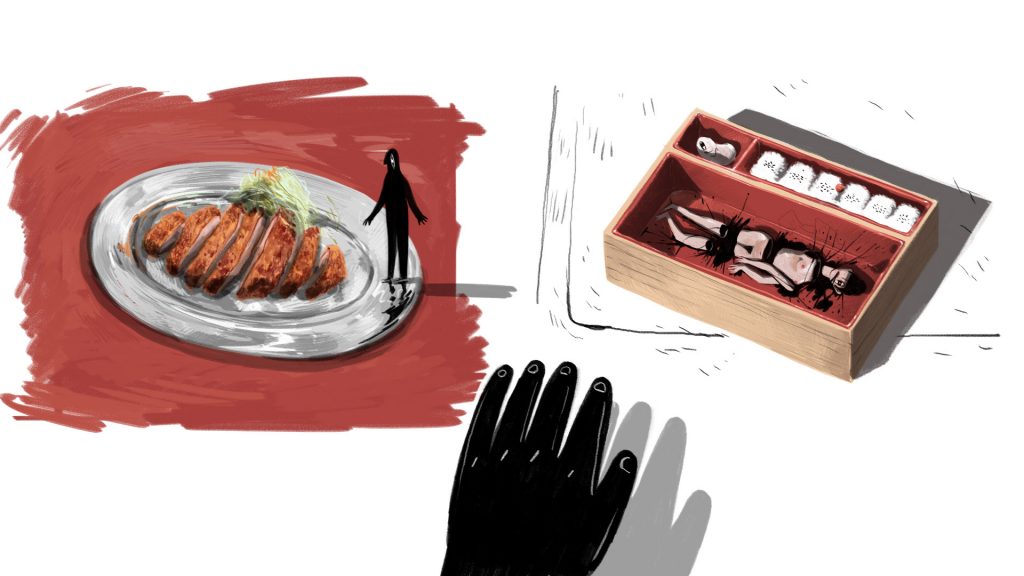
An Amnesiac Remembers
This may be the reason why I was not in the slightest prepared for the world of Umami. Once again, I was led into a tiny lobby. The door had barely shut before I saw someone charging at me: a guard. Wait, a prison guard?! I had imagined something a bit different. He shouted at me, pointing at an orange smock hanging from the wall. “Come on, get dressed! Are you aware of your crimes? Do you recognize this woman?” He pointed to some photographs hanging on the wall. “That’s your wife!” I stammered something about loving my wife a great deal – what else was I to say… The guard mustered me with a grim face. It was I who killed her, he pointed out.
Right then, a curtain opened. Through a window, I had a view of the adjoining room, where a man was standing atop a pedestal. He wore the same orange jacket as I; and also a VR headset – it’s thick cable fastened to the ceiling. A second guard yelled at the man: “Take your punishment, murderer,” – or something in that vein. He pushed a button, and the man was hanged.
The One-Eyed Man
Next, they brought me into the room. I had to sit down at the table and put on the VR headset – not a good sign, having witnessed the previous scene. The first images appeared before my eyes: in VR, I was still sat in the same room as before, now rendered in a more abstract, two-dimensional style. There were conveyor belts carrying various dishes at the edge of the room. I already knew these from sushi restaurants. By and by, bowls and cups floated onto the table in front of me, and I could touch these virtually as well as physically. They all held different dishes (including a fragrant fish).
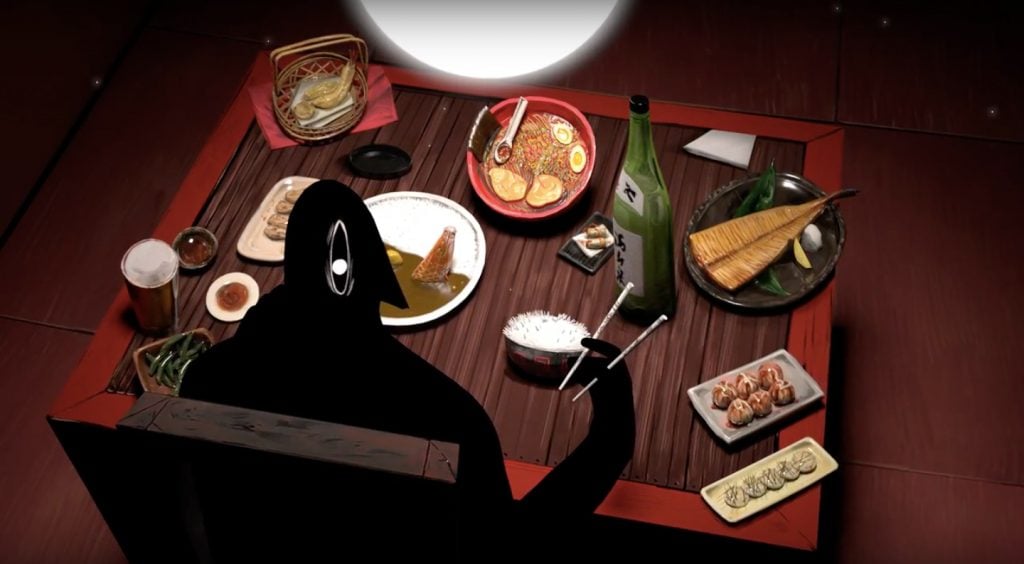
These dishes awakened “my own” memories: images of a life with “my” wife, everyday routines, bliss and anguish. At times, the memories came jumping out from the vegetables, other times I had to turn a cake to find them. The whole ordeal seemed like a nice dream, though it felt a bit untrue and like it was threatening to turn into a nightmare at any moment. The dream luckily never took a scary turn; but it did become increasingly melancholy. I saw my virtual self in the mirror: a grumpy, one-eyed man. And it dawned on me that I probably won’t get out of my imminent hanging. This was my last meal.
I will save you the ending. It wasn’t nice and I let go a little scream, too. Admittedly, I can’t recall much of the moments afterwards, but I think someone handed my trembling self a little glass of sake. Or maybe I just dreamt that – or wished for it.
What Proust Has to Do With Japan
What I can recall is the subsequent discussion I had with Landia Egal of Tiny Planets, who created Umami together with her codirector Thomas Pons, and likewise in coproduction with the DVgroup. She told me more about the origins of Umami:
Thomas Pons, an illustrator and 2D animator, started making the first pictures for Umami during his artist residency in Japan. At the time, he was coming to terms with two deaths in his family, making drawings of a lonely, one-eyed man sampling Japanese food. Back in Europe, he met Landia Egal. The two of them then decided to create a story and a VR experience based on the correlation between food and memories. They made use of the so-called Proust effect, named after his popular story from In Search of Lost Time, in which protagonist Swann savors a madeleine, whose taste sweeps him into a vivid world of memories.
While the codirectors preoccupied themselves with Japanese food, they realized that Japan has held onto the death penalty. To push the whole thing to the extreme, they decided to employ the setting of a last meal. I found the visualization of the VR-headset and its upward-reaching cable as the gallows to be very convincing.
Landia Egal sees her project as a criticism of the death penalty. For in the final version of the experience – the project that was showcased in Venice was a first test of the overall concept – the viewers will have to choose their meals and with that, decide which memories they want to relive. The life preceding this last meal will thus always be a different version: interpretations will vary, facts will change. The result, however – the death penalty – remains unchanged.
Umami and The Horrifically Real Virtuality: Similarities
As different as both pieces may have been designed in regards to content and visuals, they do share certain commonalities. For one, both integrate the act of putting on the headset into their stories. This allows users to “dive into another world” twice (or even more times). More importantly though, the technology of virtual reality takes a back seat and leaves ample room for the content.
In both plays, reality and virtual reality intertwine profoundly: the physical settings – the room of my last meal here, the film-set backdrop there – are replicated in VR. What’s more is that they often employ physical objects that can be touched and manipulated in VR.
In these worlds, actors initiate you into the story, avoiding the need for “plump” background stories completely.
And in The Horrifically Real Virtuality, one of the actors later reappeared in the virtual world – with a different look. This had already wowed me in Jack, as in this way, the actors elevate the situation to a much more interactive and intense experience – one I would gladly pay money to see.
I’m hoping to experience the extended version of Umami and many other immersive theater VR plays soon. In my opinion, this is currently the most spectacular genre VR has to offer.
Translated by Jan Mc Greal

